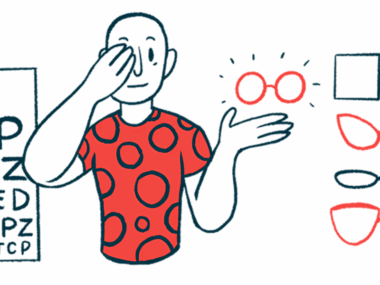How I handle depth perception and driving with MS
Caution is king when it comes to driving an automobile, given my vision issues
Written by |

Have you ever been on a flight of stairs and misjudged the height of the steps, causing you to lose your footing? That happens to me more than I’d like to admit. This misjudgment stems from our depth perception, which is our ability to view the world in three dimensions, including an object’s size and distance from us. In general, depth perception helps us navigate the world around us.
Our visual perception works in conjunction with various parts of our brain to process the things we see. However, this process can be highly affected when you have multiple sclerosis (MS), as I do. This can occur for several reasons, such as optic neuritis, which results from inflammation of the optic nerve, as well as eye muscle weakness, visual pathway lesions, or chronic fatigue.
My issues with depth perception stem from my first couple episodes of optic neuritis, which ultimately led to my MS diagnosis when I was 17 years old. In both cases, I lost the majority of vision in my left eye, which was recovered with a high dose of steroids. The demyelination of the optic nerve left lasting effects, including reduced depth perception.
One of my biggest challenges is judging distances while driving, especially when it involves curbs or other cars. I learned how to drive when I was 21, which is later than most people, so I wasn’t entirely aware of my issues with depth perception at the time. One summer, when my uncle was teaching me to drive, he noticed pretty quickly that I was uneasy about judging distances.
This made me extremely worried about whether or not I should be driving. But he assured me that there are safe ways to compensate for a lack of depth perception. The best piece of advice he gave me was to take my time while turning, parking, and merging lanes. Nothing was so important that I should risk putting myself or others in danger by rushing.
During my driving lessons and afterward, I held his words close to my heart and in my mind to ensure that I drove safely wherever I went.
I’ve also picked up other tips that have helped a lot. The first is leaving more space than I think is needed between my car and other cars. It might look silly sometimes, but it gives me peace of mind that I won’t get too close to someone else.
When I’m merging lanes or turning, I make sure to wait for an obvious break in traffic. Most of the time, I am unable to judge how fast a car is going, so there’s no harm in waiting for the right time. It also helps when I rely on all my mirrors and turn my head to check my surroundings. I’d rather be safe than sorry.
Lastly, I use nearby objects and landmarks to help me gauge sizes and distances, especially when it comes to parking. If I’m parking in a lot full of cars, I use the wheels of the car beside me as a reference point to know when to put my car in park.
Driving is not a joke, so taking precautions to ensure the safety of myself and others is always a top priority.
Note: Multiple Sclerosis News Today is strictly a news and information website about the disease. It does not provide medical advice, diagnosis, or treatment. This content is not intended to be a substitute for professional medical advice, diagnosis, or treatment. Always seek the advice of your physician or other qualified health provider with any questions you may have regarding a medical condition. Never disregard professional medical advice or delay in seeking it because of something you have read on this website. The opinions expressed in this column are not those of Multiple Sclerosis News Today or its parent company, Bionews, and are intended to spark discussion about issues pertaining to multiple sclerosis.







Andrew Scott
Still driving and can't reliably determine distance? I stopped driving because of the SINGLE time my perception felt weird at a roundabout. I concluded I couldn't drive if, especially in the case of a sudden need, I couldn't guarantee my eyes or I couldn't react to a situation. I couldn't possibly end up feeling responsible for an accident or injury for a situation I could have avoided. Indeed, the British Courts might have something to say about it! I appreciate the author is in the USA but surely the safety of OTHERS is absolutely paramount? Driving and a car are relative luxurys compared to the damage that dangerous driving can cause. The fact you relied on the reassurance of your uncle rather than a true authority left me open-mouthed.
Julie Covey
I am in Austin also. I was dx with MS many years ago (also after ON) and in the last 10 years or so, Ive had difficulty with depth perception, especially as it relates to night driving (which I don't do anymore), curbs/islands, turning, etc. I finally had a wreck a few months ago in which I fractured a vertebrae. I sideswiped and then drove into a concrete construction barrier. I was very lucky and didnt hurt anyone else. My ophthalmologist says my peripheral vision is fine. I don't think so. Anyway, I can relate to the subject.
Elizabeth Gutierrez
I loved your article, it really opened my eyes to other issues that comes with MS. I am currently having problems, parking into a spot. I don't go all the way in...I think I am in, I am so far from the curb the back end of the car is sticking out. So I started to judge with the cars parked on the sides of me, the spot I am parking into. If my front doors are event to that car, I should be fine. This all started lately, I have had MS now for 22 years. It goes to show you, it comes on when it comes on! Good luck to everyone with MS, Best Wishes, Always Stay Positive